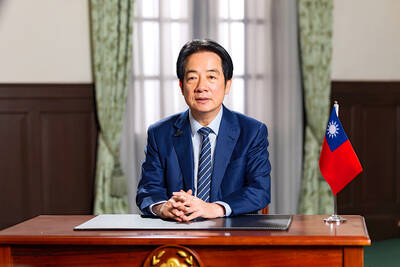Since its release last year, the immensely successful Ip Man (葉問) has elevated its eponymous grandmaster of the wing chun (詠春) martial arts school to an icon of Chinese kung fu and propelled action star Donnie Yen (甄子丹) to superstardom.
The highly anticipated sequel, Ip Man 2 (葉問2), closely follows the format that made its predecessor a blockbuster hit. But this time the Chinese hero-versus-foreign invaders narrative is fleshed out without wire fu or CGI-enhanced martial arts moves.
Yen is joined by action director Sammo Hung (洪金寶), who plays
a supporting but important role in
the follow-up that won’t disappoint fans, though it doesn’t offer many surprises.
The story begins with Ip Man (Yen) fleeing to Hong Kong having defeated the Japanese general in Foshan. To support his family, Ip Man sets up a wing chun academy. But as a newcomer to the British colony, the unassuming kung fu master soon catches the attention of master Hung of the powerful Hung Ga school. Respected by various martial arts schools, Hung insists that, in order to earn his right to teach wing chun in Hong Kong, Ip Man must win duels against local masters.
The challenge leads to a masterfully choreographed fight between Ip Man and Hung that dazzles with its sheer intensity and virtuosity, a scene that deserves to be considered one of the most memorable fighting sequences in kung fu cinema.
The duel ends in a draw, and despite the combatants’ differences, the two come to respect each other’s skills and integrity.
As with the first installment, the second half of the film follows the martial arts hero rising up against foreign oppressors. Only this time, it is not the villainous Japanese our Chinese hero does battle with, but an evil white man in the form of boxing champion Twister (Darren Shahlavi), who brutally beats master Hung to death in what was supposed to be a friendly match.
Outraged, Ip Man challenges the vicious pugilist to a final battle in front of a cheering crowd.
Veteran martial arts star Hung once again creates the adrenaline-pumping, close-range combat sequences that show Yen fighting his way through a fish market melee, tabletop duel and ringside battle.
Director Wilson Yip (葉偉信) and scriptwriter Edmond Wong (黃子桓) neatly tie these action sequences closely to the plot.
One thing that this old-school kung fu fare has gone too far with, however, is its overly caricatured portrait of foreign villains. Though in the first Ip Man movie, the Japanese general, played by Hiroyuki Ikeuchi, seems to have a shred of humanity left within him, the white men in the follow-up are comically wicked and corrupt, prompting the contemporary viewer to wonder why the villains are still as embarrassingly witless and one-dimensional as they were in Bruce Lee’s (李小龍) heyday.
Despite its plot holes, the Ip Man series has potential and recalls the 1990s’ Once Upon a Time in China (黃飛鴻) franchise starring Jet Li (李連杰). The brief appearance toward the end of the film of a young Bruce Lee, Ip Man’s famous disciple, hints at the possibility of another sequel, though Yen has reportedly said he won’t be in another Ip Man movie.
What is certain is that competing Ip Man projects will soon hit the silver screen, including Wong Kar-wai’s (王家衛) The Grand Master (一代宗師), currently in development, and Herman Yau’s (邱禮濤) prequel The Legend is Born — Ip Man (葉問前傳), slated for commercial release in July.

This month the government ordered a one-year block of Xiaohongshu (小紅書) or Rednote, a Chinese social media platform with more than 3 million users in Taiwan. The government pointed to widespread fraud activity on the platform, along with cybersecurity failures. Officials said that they had reached out to the company and asked it to change. However, they received no response. The pro-China parties, the Chinese Nationalist Party (KMT) and Taiwan People’s Party (TPP), immediately swung into action, denouncing the ban as an attack on free speech. This “free speech” claim was then echoed by the People’s Republic of China (PRC),

Exceptions to the rule are sometimes revealing. For a brief few years, there was an emerging ideological split between the Democratic Progressive Party (DPP) and Chinese Nationalist Party (KMT) that appeared to be pushing the DPP in a direction that would be considered more liberal, and the KMT more conservative. In the previous column, “The KMT-DPP’s bureaucrat-led developmental state” (Dec. 11, page 12), we examined how Taiwan’s democratic system developed, and how both the two main parties largely accepted a similar consensus on how Taiwan should be run domestically and did not split along the left-right lines more familiar in

Many people in Taiwan first learned about universal basic income (UBI) — the idea that the government should provide regular, no-strings-attached payments to each citizen — in 2019. While seeking the Democratic nomination for the 2020 US presidential election, Andrew Yang, a politician of Taiwanese descent, said that, if elected, he’d institute a UBI of US$1,000 per month to “get the economic boot off of people’s throats, allowing them to lift their heads up, breathe, and get excited for the future.” His campaign petered out, but the concept of UBI hasn’t gone away. Throughout the industrialized world, there are fears that

The Democratic Progressive Party (DPP) controlled Executive Yuan (often called the Cabinet) finally fired back at the opposition-controlled Legislative Yuan in their ongoing struggle for control. The opposition Chinese Nationalist Party (KMT) and Taiwan People’s Party (TPP) acted surprised and outraged, but they should have seen it coming. Taiwan is now in a full-blown constitutional crisis. There are still peaceful ways out of this conflict, but with the KMT and TPP leadership in the hands of hardliners and the DPP having lost all patience, there is an alarming chance things could spiral out of control, threatening Taiwan’s democracy. This is no